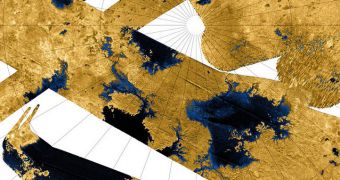Saturn's largest moon, Titan, may be more similar to Enceladus, another moon orbiting the planet, than astronomers first realized. New datasets appear to indicate that the former also has a liquid ocean beneath the surface. If this is confirmed, then Titan will officially become the weirdest moon ever.
Some of the peculiarities this object displays include a complete, methane-based atmospheric cycle, complete with storms, thunders, lightnings, lakes, and rivers. The liquid hydrocarbon is everywhere, forming vast accumulations at the moon's north and south poles.
A thick atmosphere is surrounding this amazing object, and the most interesting thing about this particular atmosphere is that it has numerous layers, similar to Earth's. This made Titan a favorite target for theories seeking to demonstrate the existence of life elsewhere in the solar system as well.
But now, the moon could become even more interesting, as studies indicate an underground ocean may exist right under its surface. On the ice-covered Enceladus this makes more sense, but the discovery of such a possibility on Titan really came as a surprise for astronomers, Universe Today reports.
Experts at the Royal Observatory of Belgium discovered an unusual rotational inertia on the moon. The group was peering through data on Titan's rotation and orbit, which were obtained by the NASA Cassini orbiter. The spacecraft has been analyzing Saturn since July 1, 2004.
What this discovery means is that the object does not have an entirely-solid body. The major implication here is that the moon is either filled with liquid, or that it has a massive ocean buried underneath its surface.
The ROB team says that it's still too early to determine the depth of the newly-found ocean, or how far below the moon's surface it lies. In order to conduct these calculations, scientists will need to approach the study of Saturn's largest moon in an entirely new manner.
“We propose a new Cassini state model for Titan in which we assume the presence of a liquid water ocean beneath an ice shell,” say investigators in a new paper detailing the findings. The group was led by astronomer Rose-Marie Baland.
“With the new model, we find a closer agreement between the moment of inertia and the rotation state than for the solid case, strengthening the possibility that Titan has a subsurface ocean,” the team adds.
This model is also very efficient at explaining why the moon is enshrouded in a thick, hazy atmosphere. The compounds it contains are produced by the breaking-down of natural gas (methane), but the origins of the gas have thus far remained a mystery.
If Titan has a liquid inner shell, then the methane could originate from within, similar to how water vapors shoot out of Enceladus' south pole, fueling Saturn's E Ring.

 14 DAY TRIAL //
14 DAY TRIAL //